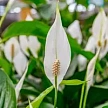
Spathiphyllum
Grateful indoor flower
| Latin name | Spathiphyllum |
| Homeland | South America, Malaysia |
| Family | Araceae |
| Cultivation | relatively simple |
| Location | well lit |
| Temperature | 16-27 °C |
| Watering | plentiful in summer |
| Flowering time | in summer |
| Height | 0.15-1.0 m |
| Transplanting | in spring |
| Appearance maintenance | remove withered flowers and leaves |
The genus Spathiphyllum includes more than 30 tropical plant species originating from South America and Malaysia. All hybrids grown as houseplants are derived from Spathiphyllum wallisii, native to Colombia. It is a small plant with paddle-shaped glossy bright green leaves about 30 cm long., with wavy edges and pronounced veins. Small and round real flowers of creamy-white color are collected in an inflorescence (small ear), wrapped in a white bract leaf (blanket). Maturing, both the cob and the blanket acquire a green color. Spathiphyllum flowers are very stable, long flowering. There are many decorative varieties and varieties, both small, such as 'Small', which is widely used in compositions, and very large, such as 'Mauna Loa' and 'Giant'. Other popular varieties include 'Bold', 'Feeling', 'Adagio', 'Prelude' and 'Palace'.
The genus Spathiphyllum includes more than 30 tropical plant species originating from South America and Malaysia. All hybrids grown as houseplants are derived from Spathiphyllum wallisii, native to Colombia. It is a small plant with paddle-shaped glossy bright green leaves about 30 cm long.,
with wavy edges and pronounced veins. Small and round real flowers of creamy-white color are collected in an inflorescence (small ear), wrapped in a white bract leaf (blanket). Maturing, both the cob and the blanket acquire a green color. Spathiphyllum flowers are very stable, long flowering. There are many decorative varieties and varieties, both small, such as 'Small', which is widely used in compositions, and very large, such as 'Mauna Loa' and 'Giant'. Other popular varieties include 'Bold', 'Feeling', 'Adagio', 'Prelude' and 'Palace'.
Cultivation
Wallis spathiphyllum is cultivated only as a houseplant. When growing, mineral fertilizers must be used. In spring and summer, from the end of March to the end of September, diluted liquid fertilizer is added to the water every 10 days when watering strongly developed specimens (for feeding weak plants, fertilizer is taken in a lower concentration). In the rest of the year, regardless of size, plants are fed once a month. Spathiphyllum is ideal for hydroponics.
Location
Wallis spathiphyllum likes a well-lit place, especially in winter. In summer, you need to make sure that they are not exposed to direct sunlight, which causes burns to the leaves. Best of all for them - partial shade.
Temperature
The winter temperature should not be high: optimally - about 16 °C - then there is a rest period that promotes flowering in summer. The plant can tolerate temperatures not lower than 12-13 °C. In the summer months, spathiphyllum feels comfortable at a temperature of 25-27 °C. Does not like sudden temperature changes and drafts.
Watering
It is necessary to constantly maintain moderate, possibly high, humidity. Therefore, abundant watering (there should be good drainage) and frequent water spraying of the aboveground part are required. To establish the optimal humidity level, you can also place the pot in a pallet with expanded clay. Watering is less frequent in winter.
Transplant
If you can see that the roots of the plant have filled the entire volume of the pot, then proceed to transplant. This operation is performed in the spring, even annually, using the usual universal humus, which is filled with a pot that is 1-2 sizes larger than the previous one.
Care
The leaves are cleaned with a damp cloth (the use of lustrating solutions is not recommended). Withered leaves and inflorescences (an ear enclosed in a blanket) should be removed by cutting them off at the junction with the stem.
Reproduction
The simplest way to propagate spathiphyllum is to divide the bush in the spring. The roots are also carefully separated. Plants obtained as a result of division should be planted in pots or cups filled with loose peat soil with a pH of 5.5-6, pouring a good drainage layer on the bottom; the temperature is maintained at about 20 °C.
Diseases
Spathiphyllum plants are usually quite stable. When affected by mites, small yellowish specks appear on the leaves; they are eliminated by treatment with acaricides, as well as by maintaining high humidity. Worms hiding in the most closed places provoke gradual wilting and death of the plant. This pest is eliminated by treating it with a cotton swab soaked in alcohol, after which the plant is sprayed with an anticoccidal drug. If aphids appear on young shoots, this leads to deformation and twisting of the leaves into tubes. Appropriate processing is required.
Acquisition
Seedlings of spathiphyllum varieties are very easy to purchase both in flower shops and in gardening centers. Plants should be bought when the bracts are still closed.